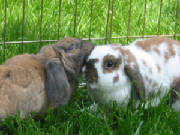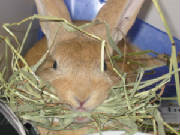 |
 |
|
|

|
|
For Cinnabun & Marbles, it was not love at first site, but
now they are inseparable! |
|
Thinking about adopting a bunny? Consider
adopting a bonded pair! Rabbit Rescue always has bonded
pairs up for adoption. Rabbits do alright on their own if
you have lots of time to spend with them, but we believe
they are happier with a bunny friend. They are great
company for each other if you are gone during the day.
Looking for a friend for your current bunny?
Best match for bonding is a neutered male and spayed
female. Rabbits of the same sex are much more difficult to
bond as they can be territorial. Both rabbits should be
fixed prior to bonding. Size, colour or breed do not matter
to the other bunny, but what you do want to look for is a compatibale
personality match - dominant and submissive are usually the
best match. Once bonded, rabbits can share a litter box and
food bowls. They will prefer being housed together, as
being separated from their mate can be very stressful.
How to: We recommend housing the rabbits side
by side for a minimum of 2-3 weeks before introducing them
to each other. This allows them to get used to each others
scent. You may also try switching their cages and litter
box, as this can decrease territoriality and, and get them
more used to each other. When they are introduced, it should
be in a neutral territory (ie a bathtub works very well!).
Both rabbits should be spayed and neutered (and remember
that a neutered male can get an unspayed female pregnant for
up to 2 months after his surgery). Wear over mitts so you
can grab a rabbit if fighting occurs, or have a water spray
bottle handy to discourage nipping. Short bonding sessions
are recommended until they get more comfortable with each
other (IE 1-2 minutes). Do not let them fight, chase or
circle each other. Rabbits DO hold grudges, and this will
hinder the bonding process. If the rabbits are not bonding
after many sessions, you can try taking them for a car ride
together (in a carrier). This often helps the bonding
process. The key to bonding is being patient, and taking
things very slowly.
|
|
 |
 |
 |
 |
|
|

|
|
'Harvest' knows that hay is a very important part of his
diet. |
|
Hay is an extremely important part of an
rabbits diet. Alfalfa hay is fine for baby bunnies, but
once mature, they should be feed timothy, or mixed grasses
(ie brome, orchard, oat, timothy). If your rabbit is
fussy, try buying fresh hay from a local farm or feed
supply store. Be sure to buy 'horse quality' (not cow
quality), and inspect it carefully for mold, which is
toxic to rabbits.
Organic hay may also be ordered from
www.oxfordmeadowshay.com
which grows mixed grass hay specifically for rabbits. Our
rescue bunnies LOVE it!
Rabbits also love their veggies! Be sure
to wash them carefully to remove debris and pesticides.
Some recommended vegetables include parsley, romaine, red
leaf, endive, mesculine, dandelions and carrot tops. Be
sure to use fruits/vegs that are high in sugar (apples,
carrots, bananas) as a treat only. Vegetables high in
calcium (broccoli, kale, spinach) should be used
sparingly. For a list of safe bunny veggies, visit:
http://www.adoptarabbit.com/articles/packet/abcvegi.html
For a list of toxic plants, see:
Pellets should make up the smallest part of
a rabbits diet. Look for a pellet that is low in calcium
and fiber and high in protein. A 5-7 pound rabbit should
only be fed 1/4 cup of pellets/day
|
|
 |
 |
 |
 |
|
|
|
Grooming
Brushing should be enjoyable for both you and
your rabbit. We recommend using wire slicker brushes for
picking up lots of fur. If rabbits are not brushed
regularly, they can develop wool block (fur balls). As
rabbits are unable to throw up, these fur balls can create a
blockage that can be quite serious. Rabbits molt 4 times
each year, and will need extra brushing during that time.
Nail Triming
Rabbits need to have their nails trimmed
aprox every 1-2 months. When trimming nails, locate the
quick (where the blood vessles are) and make sure you leave
a small space between where you are cutting and the quick.
Always a good idea to have styptic power on hand in case a
quick is cut (corn starch will help it clot in an
emergency). Place your rabbit in a calm, quiet area so its
heart rate will slow down and the bleeding will stop. If
your rabbit has dark nails, you can use a flashlight to back
light the nail and locate the quick. If you are not
comfortable trimming nails, your vet can show you how.
Rabbit Rescue Inc. also offers nail trimming services.
|
|
 |
 |
 |
 |
|
|
|
There are many options to 'house' your
rabbits. Most rabbit 'cages' are much too small for the
rabbits. There should be enough room for the rabbit to
stretch up, lay down fully, to hold a litter box, food &
water dish, toys, and enough room to hop around a bit. The
bigger the better!!
Be cautious of top opening cages - never let
your rabbit jump out of them on their own. We have received
many emails from owners who's bunnies have tried to jump
out, only to get caught half in and half out when the
door falls closed on them. Most do not survive.
Wire bottom cages can be rough on bunny
feet. If you have a wire cage, remember to cover the wire
(cardboard, newspaper, old tshirts etc) to protect their
feet. Being housed on metal can cause sore hocks for
bunnies.
Some smart housing options:
Dog Crates - Dog crates work well to house
rabbits, as the come in larger sizes. They can be messy,
as they do not have high sides. To solve this,
you can fasten coroplast around the bottom to prevent hay,
paper etc from being kicked out.
Creative Cubes - Creative cubes work very
well and can be found at most Walmarts, Costcos and Home
Depots in the shelving department. Normally sold for
shelving units, they make excellent rabbit or guinea pig
cages! They are inexpensive and can be made as large as you
like! Linoleum or coroplast can be used for the bottom.
|
|
 |
 |
 |
 |
|
|
|
Bunnies love to play with toys!! There are
many things you can make for them that are very
inexpensive. IE) toilet paper rolls, paper bags filled with
treats and hay and tied off at the top. Baby toys are
great, as are hard plastic cat toys. Stay away from anything
made out of soft plastic that they could injest. Providing
them with their own toys will discourage them from chewing
your things! Untreated wicker baskets are fun for them to
chew, as well as old phone books.
To order some bunny toys, you can visit:
|
|
 |
 |
|